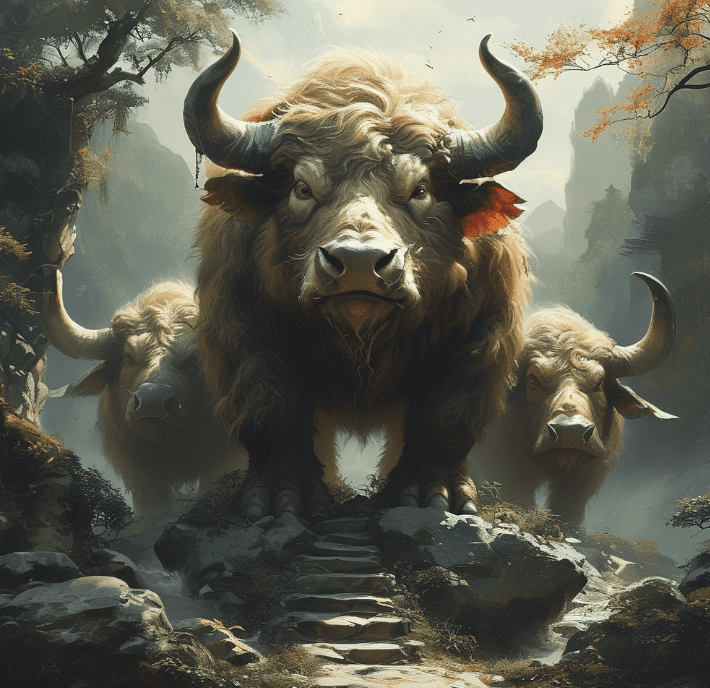I. Ta Sui
Ta Sui was originally an honorific title for a deity in Taoism, corresponding to the divine spirits of heaven and earth, and later used to predict one’s fortune. Ancient texts state: “The color of the year determines the power of weapons and the life and death of people.” It also says: “In the year of Ta Sui, there will be no joy but disasters.” Ancient people believed that each year, a Ta Sui deity governs all worldly affairs of that year, and there are sixty Ta Suis in total, rotating through the sixty Jiazi years. These sixty Ta Suis cycle endlessly, hence they are also called “annual messengers.” Since most Ta Suis are of a military background, they are all given the title of “General” in Taoism. The statues of each Ta Sui have different expressions and hold various instruments, hinting at the fortune of the year. For example, if a Ta Sui holds a brush, it signifies political changes in that year; if it holds a spear or sword, it indicates the need to strive and make efforts. Whether one commits a crime, clashes, breaks, or harms, they are all affected by the annual Ta Sui, which can easily lead to legal disputes, career stagnation, investment failures, emotional fluctuations, interpersonal conflicts, and romantic separations. In severe cases, there may be accidents and bloodshed.
II. Four Symbols
The “Four Symbols” refer to the Azure Dragon on the left, the White Tiger on the right, the Vermilion Bird in front, and the Black Tortoise at the back. The “Four Symbols” are also known as the Four Beasts. Feng Shui experts believe that the Four Symbols are born from the energy of the four directions. If they can lie down gently and protect the central land, it is a great auspicious sign, capable of blessing the descendants with wealth and honor. The “Four Symbols” originated from the four heavenly deities in Taoism. Later, ancient people divided the stars in the ecliptic into twenty-eight constellations, called the “Twenty-Eight Mansions.” They then combined the Twenty-Eight Mansions with the Four Images, forming the concepts of the “Twenty-Eight Mansions” and the “Four Images.” Among them, the seven mansions in the east—Jiao, Kang, Di, Fang, Xin, Wei, and Ji—are located in the east. According to the theory of Yin-Yang and the Five Elements, the east is associated with the color blue, hence they are called the “Azure Dragon.” This leads to the concepts of the Black Tortoise in the north, the White Tiger in the west, and the Vermilion Bird in the south. The Azure Dragon, White Tiger, Vermilion Bird, and Black Tortoise are collectively referred to as the “Four Images.”
III. Sha
“Sha,” also known as “Sha Tou,” is a term used by geomancers to refer to the mountains in front of, behind, and to the left and right of a dragon-vein site. The name comes from the ancient practice of geomancers using sand to shape mountains to teach the methods of finding dragon-veins and pinpointing auspicious sites. Xu Shanjie’s “Essentials for Offspring – Sand Methods” records: “The so-called ‘Sha’ refers to the mountains in the wilderness in front of, behind, and to the left and right of the site… the mountains in front that embrace, those behind that support, the left dragon, the right tiger, the encircling city, the attendants, the water mouth mountains, as well as the mountains of officials, ghosts, birds, and stars, are all called ‘Sha.'” Liao Yu’s “Leaking Heavenly Secrets – Song of Eliminating Sands” also says: “Where the true dragon descends, four mountains gather, and there is a natural name. Why did the sages of old call it ‘Sha’? The principle calls for a difference. Yang and Zeng taught people with a certain pattern, and the five and nine are only selected from the sands, hence the name ‘Sand Selection Classic’ was given.”
IV. Ming Tang
In ancient China during the pre-Qin period, the place where the emperor met with feudal lords and conducted sacrificial activities was called Ming Tang, which was a place for the emperor to proclaim and clarify political teachings. Later, in Feng Shui, it came to refer to the area in front of the main door of a yang residence or in front of a yin residence, a place where the earth’s energy gathers. The area inside the case mountain is the Great Ming Tang, also known as the Outer Ming Tang, the area within the dragon and tiger hearts is the Middle Ming Tang, and the area in front of the site is the Small Ming Tang, also known as the Inner Ming Tang. The ancient Ming Tang is considered best when it is clean, spacious, protected from the wind, and able to gather energy. When geomancers select a site, they first choose a good Ming Tang, and then pinpoint the site to achieve the purpose of seeking auspiciousness and avoiding misfortune.



